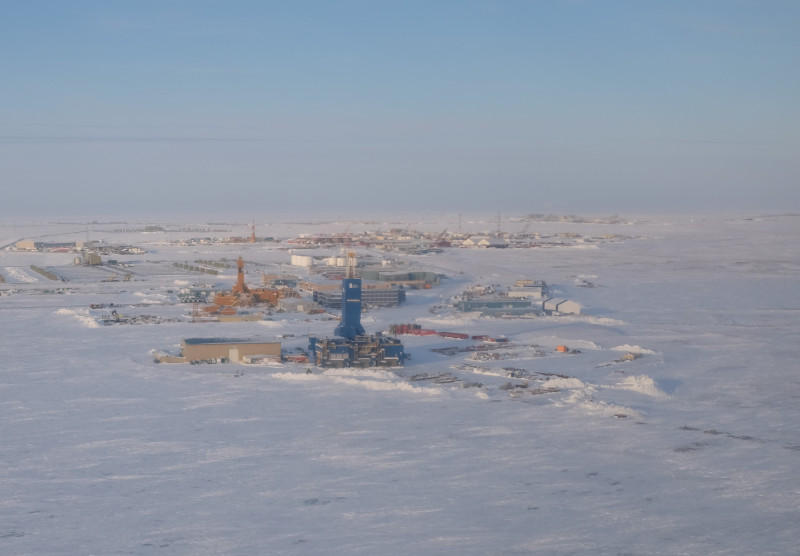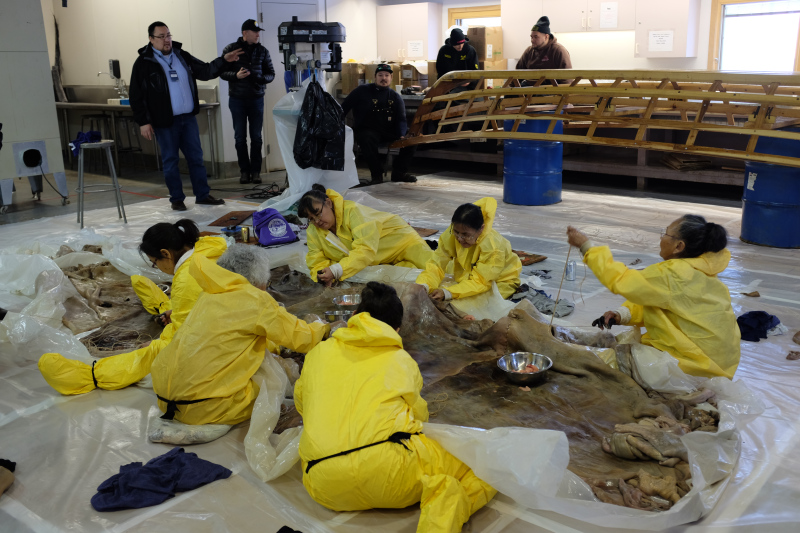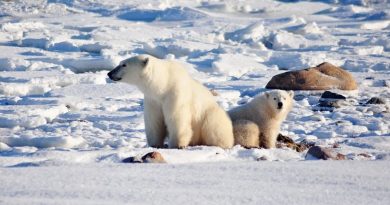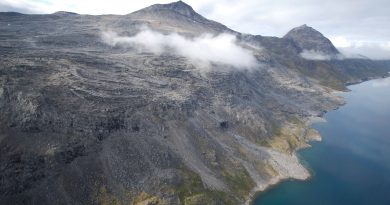Blog: In the Arctic Ocean, an Alaska Native corporation seeks to fill void left by Shell

When Shell aborted its $7 billion Arctic drilling efforts in the Beaufort Sea in September 2015, environmentalists breathed a sigh of relief. The multinational corporation’s 28-vessel fleet, including its drillship and drill rig, quietly sailed south from Alaska towards warmer waters, avoiding any such catastrophes like the Kulluk’s grounding in 2013.
Those opposed to drilling for oil in the Arctic Ocean felt even more encouraged when the U.S. and Canada jointly banned new leases for Arctic oil and gas drilling in December of last year. Expanded Arctic fossil fuel exploration, it was hoped in some circles, would be postponed indefinitely, at least in North America.
Yet little attention has been paid to what happened to Shell’s leases after the oil company quit Alaska. Just days before the moratorium was announced, 21 leases in a part of the Beaufort Sea Lease Area called Camden Bay were purchased in 2016 by a subsidiary of Arctic Slope Regional Corporation (ASRC), the wealthiest Native corporation in Alaska. At about precisely the same time that ASRC was criticizing Obama’s ban on further developments in the Outer Continental Shelf, the protests at Standing Rock against the Dakota Access Pipeline were exploding. If you thought that all indigenous peoples were uniformly opposed to oil drilling, think again.
According to a list provided by the Bureau of Ocean Energy Management, most of the leases purchased by ASRC Exploration are set to expire at the end of this year. Two are valid until summer 2019. In order to prevent the expiration of nearly all of the leases, as Alex DeMarban at Alaska Dispatch News writes, ASRC Exploration requested unitization of the offshore leases from the U.S. Bureau of Safety and Environmental Enforcement (BSEE). Unsurprisingly, under an administration that’s more pro-oil than the previous one, BSEE approved the unitization of 20 of the 21 units.
ASRC’s next step
The benefits of unitization are that whatever happens in one lease now applies to all other 20 leases, since they’re now considered part of the same area. Petroleum News explains, “Unitization binds together a group of leases, which often have multiple owners, to encourage orderly and thorough exploration and production with minimal waste of dollars or resources.” For ASRC, this means if they find oil in one lease area, the rest of their leases stay active and exploration can continue.
The next challenge for ASRC will be to successfully obtain an extension of the leases from BSEE. Shell wasn’t able to do this earlier, but that was under the Obama administration. Under Trump, things could be different.
Ty Hardt, Senior Director of Communications at ASRC, wrote over email,
A different indigenous narrative

Since its formation in 1971 under the Alaska Native Claims Settlement Act, ASRC has transformed into a major economic force in Alaska and beyond. In 2010, Forbes ranked it the 190th largest private company in the U.S., just behind Burger King, with revenues of $2.33 billion. The corporation represents the interests of some 13,000 Iñupiat shareholders, most of whom reside in seven villages scattered across Alaska’s North Slope. Every quarter, Iñupiat receive dividends from ASRC, whose value often reflects whether oil has been up or down.
ASRC’s active involvement in Arctic industrial development puts a spin on the usual narrative that’s woven of Arctic indigenous peoples being both victims of outside exploitation and staunch protectors of the environment. The regional corporation’s bread and butter has been oil field services for a long time, but it’s also been involved in mineral exploration for decades. In 1991, for instance, the Alaska legislature awarded $2 million to the company for coal exploration and feasibility studies in northern Alaska. Even back then, potential export markets were Asia and Europe via a “northern Arctic Ocean sea route,” as a 1992 report from the Alaska Department of Natural Resources referred to it. Since the late 2000s, ASRC’s interest in oil exploration has grown.
Apart from natural resource development, ASRC, like all Alaska Native corporations, is also able to expand rapidly in government services largely due to the 8(a) Business Development Program. This is intended to help businesses owned by people who have been historically disadvantaged to compete in the marketplace by allowing them to receive government contracts without having to compete with other bids. Unlike other companies classified under the 8(a) program, Alaska Native corporations have no upper limit on the size of government contracts they can receive. This exception has allowed some Native corporations, like ASRC, to grow so big that not only are they attempting to fill the shoes of Shell on the North Slope. They’re also doing things like hiring cyber security engineers in Saudi Arabia.
What about climate change?
I asked Hardt, the ASRC communications director, what he would say to those who would argue that ASRC’s oil exploration might exacerbate Arctic climate change and jeopardize the well-being of future generations of Iñupiat shareholders. He responded,
His words resonated with a conversation I had in March with Crawford Patkotak, Chairman of ASRC’s Board of Directors, at the Ukpeaġvik Iñupiat Corporation’s (UIC) Arctic Business Development Tour in Utqiaġvik (Barrow), Alaska last March. Patkotak stressed the need for self-driven development rather than government handouts for Alaska Natives. He noted,
Anti-whaling and seal-clubbing protestors aside, one could argue that ASRC is simply a for-profit corporation that doesn’t really have the best interests of all its shareholders in mind. After all, Native corporations have had their fair share of scandals, from fraud and self-dealing within the Cape Fox Corporation to the dissolution of the 13th Regional Corporation after some pretty heinous corporate mismanagement. So maybe ASRC, in exploring for Arctic oil, is really just looking out for its wallet rather than its shareholders.
Economic development V.S. traditional practices

This is certainly a possibility, but Arctic oil is no easy game to play. Instead, ASRC could just stick to its tried and true practice of winning 8(a) contracts. But that doesn’t necessarily help to build an economic base for the future, which is what ASRC is trying to do in spurring Arctic oil extraction — even if the economics of it seem crazy at the moment. And beyond mere dollars and cents, the story here is also about protecting not only indigenous rights to traditional cultural practices, but protecting indigenous rights to develop. In some cases, the two are even intertwined. Economic development can generate the funds necessary to support traditional cultural practices that, for better or worse, might not be viable on their own anymore in an economy that has both subsistence and market practices. Making a sealskin boat for whaling, for instance, doesn’t come cheap. Sure, the sealskins and caribou intestine thread come from the land, but the wood has to be purchased, and later the motor and fuel, and so on and so forth.
The words of an Elder I spoke to in Utqiaġvik reflected the determination of some Iñupiat to move forward with economic development. I asked Wesley Uġiaqtaq Aiken, a former whaling captain and World War II veteran, how he felt about oil and gas exploration. He mentioned the recent discovery of oil at Smith Bay on the North Slope and recalled how in days long past, Iñupiat used to haul seeping oil that had dried up on the bay’s surface to burn on shore. Looking to the future, Aiken remarked,
He was hopeful, but also wary of outside intervention whether it was for or against oil drilling. Underscoring the importance of recognizing and upholding Native rights to the land and sea, the Elder reflected, “The Arctic Ocean is my beautiful garden – nobody messes around with it.”
This post first appeared on Cryopolitics, an Arctic News and Analysis blog.
Related stories from around the North:
Canada: Angry Inuk: Canadian filmmaker takes on anti-sealing groups, Radio Canada International
Finland: Sámi concerned about Arctic railway plans, Yle News
Germany: Cheap oil from the Arctic? Fake news, says climate economist Kemfert, blog by Irene Quaile, Deutsche Welle
Norway: Norway offers oil companies 93 new blocks in Arctic waters, The Independent Barents Observer
Russia: Record oil volumes shipped out of Russian Arctic, says company, The Independent Barents Observer
Sweden: First building moved as northern Sweden town is relocated, Radio Sweden
United States: Alaska Native corporation plans to explore for oil in Arctic Ocean, where Shell failed, Alaska Dispatch News




